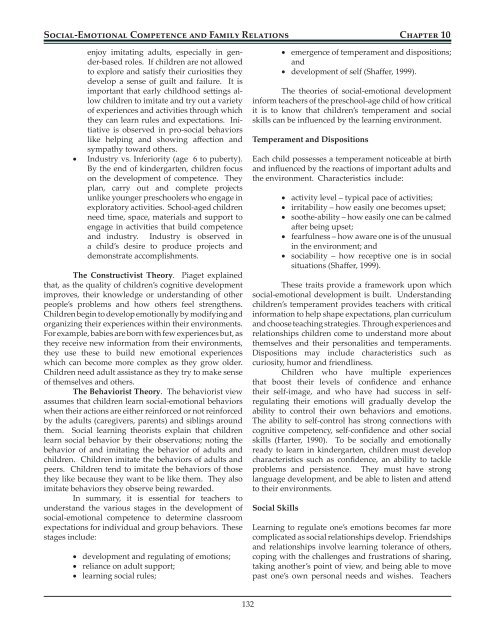Early Childhood - Connecticut State Department of Education
Early Childhood - Connecticut State Department of Education
Early Childhood - Connecticut State Department of Education
Create successful ePaper yourself
Turn your PDF publications into a flip-book with our unique Google optimized e-Paper software.
Social-Emotional Competence and Family Relations Chapter 10<br />
enjoy imitating adults, especially in gender-based<br />
roles. If children are not allowed<br />
to explore and satisfy their curiosities they<br />
develop a sense <strong>of</strong> guilt and failure. It is<br />
important that early childhood settings allow<br />
children to imitate and try out a variety<br />
<strong>of</strong> experiences and activities through which<br />
they can learn rules and expectations. Initiative<br />
is observed in pro-social behaviors<br />
like helping and showing affection and<br />
sympathy toward others.<br />
• Industry vs. Inferiority (age 6 to puberty).<br />
By the end <strong>of</strong> kindergarten, children focus<br />
on the development <strong>of</strong> competence. They<br />
plan, carry out and complete projects<br />
unlike younger preschoolers who engage in<br />
exploratory activities. School-aged children<br />
need time, space, materials and support to<br />
engage in activities that build competence<br />
and industry. Industry is observed in<br />
a child’s desire to produce projects and<br />
demonstrate accomplishments.<br />
The Constructivist Theory. Piaget explained<br />
that, as the quality <strong>of</strong> children’s cognitive development<br />
improves, their knowledge or understanding <strong>of</strong> other<br />
people’s problems and how others feel strengthens.<br />
Children begin to develop emotionally by modifying and<br />
organizing their experiences within their environments.<br />
For example, babies are born with few experiences but, as<br />
they receive new information from their environments,<br />
they use these to build new emotional experiences<br />
which can become more complex as they grow older.<br />
Children need adult assistance as they try to make sense<br />
<strong>of</strong> themselves and others.<br />
The Behaviorist Theory. The behaviorist view<br />
assumes that children learn social-emotional behaviors<br />
when their actions are either reinforced or not reinforced<br />
by the adults (caregivers, parents) and siblings around<br />
them. Social learning theorists explain that children<br />
learn social behavior by their observations; noting the<br />
behavior <strong>of</strong> and imitating the behavior <strong>of</strong> adults and<br />
children. Children imitate the behaviors <strong>of</strong> adults and<br />
peers. Children tend to imitate the behaviors <strong>of</strong> those<br />
they like because they want to be like them. They also<br />
imitate behaviors they observe being rewarded.<br />
In summary, it is essential for teachers to<br />
understand the various stages in the development <strong>of</strong><br />
social-emotional competence to determine classroom<br />
expectations for individual and group behaviors. These<br />
stages include:<br />
• development and regulating <strong>of</strong> emotions;<br />
• reliance on adult support;<br />
• learning social rules;<br />
132<br />
• emergence <strong>of</strong> temperament and dispositions;<br />
and<br />
• development <strong>of</strong> self (Shaffer, 1999).<br />
The theories <strong>of</strong> social-emotional development<br />
inform teachers <strong>of</strong> the preschool-age child <strong>of</strong> how critical<br />
it is to know that children’s temperament and social<br />
skills can be influenced by the learning environment.<br />
Temperament and Dispositions<br />
Each child possesses a temperament noticeable at birth<br />
and influenced by the reactions <strong>of</strong> important adults and<br />
the environment. Characteristics include:<br />
• activity level – typical pace <strong>of</strong> activities;<br />
• irritability – how easily one becomes upset;<br />
• soothe-ability – how easily one can be calmed<br />
after being upset;<br />
• fearfulness – how aware one is <strong>of</strong> the unusual<br />
in the environment; and<br />
• sociability – how receptive one is in social<br />
situations (Shaffer, 1999).<br />
These traits provide a framework upon which<br />
social-emotional development is built. Understanding<br />
children’s temperament provides teachers with critical<br />
information to help shape expectations, plan curriculum<br />
and choose teaching strategies. Through experiences and<br />
relationships children come to understand more about<br />
themselves and their personalities and temperaments.<br />
Dispositions may include characteristics such as<br />
curiosity, humor and friendliness.<br />
Children who have multiple experiences<br />
that boost their levels <strong>of</strong> confidence and enhance<br />
their self-image, and who have had success in selfregulating<br />
their emotions will gradually develop the<br />
ability to control their own behaviors and emotions.<br />
The ability to self-control has strong connections with<br />
cognitive competency, self-confidence and other social<br />
skills (Harter, 1990). To be socially and emotionally<br />
ready to learn in kindergarten, children must develop<br />
characteristics such as confidence, an ability to tackle<br />
problems and persistence. They must have strong<br />
language development, and be able to listen and attend<br />
to their environments.<br />
Social Skills<br />
Learning to regulate one’s emotions becomes far more<br />
complicated as social relationships develop. Friendships<br />
and relationships involve learning tolerance <strong>of</strong> others,<br />
coping with the challenges and frustrations <strong>of</strong> sharing,<br />
taking another’s point <strong>of</strong> view, and being able to move<br />
past one’s own personal needs and wishes. Teachers

















